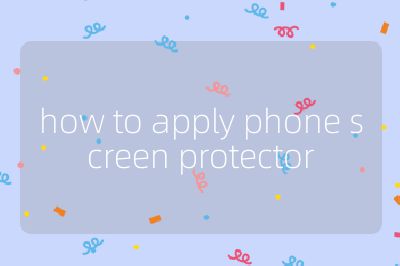How to Apply a Phone Screen Protector
Applying a phone screen protector is a straightforward process, but it requires careful attention to detail to ensure that the protector adheres properly and provides maximum protection. Here’s a step-by-step guide on how to apply a phone screen protector effectively.

Step 1: Gather Your Materials
Before you begin, make sure you have all the necessary materials:
- A high-quality screen protector (tempered glass or plastic film)
- A microfiber cloth
- An alcohol wipe or cleaning solution
- Dust removal stickers (often included with the screen protector)
- A credit card or similar object (optional, for smoothing out bubbles)
Step 2: Clean Your Phone Screen
The first and most crucial step is to clean your phone’s screen thoroughly:
- Use an alcohol wipe or cleaning solution to remove any fingerprints, smudges, or dirt from the screen.
- Wipe the screen with a microfiber cloth to ensure it is dry and free of lint.
- Inspect the screen under good lighting to ensure there are no remaining particles.
Step 3: Remove Dust Particles
Even tiny dust particles can cause bubbles under the screen protector:
- Use dust removal stickers to pick up any remaining dust from the surface of your phone.
- Gently press the sticker against any visible dust spots until they adhere and lift away.
Step 4: Align the Screen Protector
Carefully align the screen protector with your phone:
- Hold the screen protector by its edges without touching the adhesive side.
- Position it over your phone’s display, ensuring that it aligns perfectly with edges, camera cutouts, and sensors.
- Some protectors come with alignment tabs that can help in this process.
Step 5: Apply the Screen Protector
Once aligned, it’s time to apply:
- Slowly lower one edge of the screen protector onto your phone’s display while keeping it aligned.
- Gradually let go of the rest of the protector so that it falls into place.
- If using a tempered glass protector, press down gently on the center of the protector; this will help push out air bubbles toward the edges.
Step 6: Smooth Out Air Bubbles
If air bubbles form during application:
- Use a credit card wrapped in a microfiber cloth to gently push out any bubbles towards the edges of the device.
- If some bubbles remain after smoothing, they may disappear over time as adhesive settles.
Step 7: Final Inspection
After applying and smoothing out any bubbles:
- Inspect your work carefully for any imperfections or misalignments.
- If everything looks good, allow some time for adhesive curing as per manufacturer instructions (usually around 24 hours).
By following these steps carefully, you can successfully apply a phone screen protector that will help safeguard your device from scratches and damage.
Probability that this answer is correct: 95%
Top 3 Authoritative Sources Used in Answering this Question
iFixit A well-known resource for repair guides and tutorials covering various electronic devices, including smartphones.
Lifewire An online technology publication providing detailed how-to articles and product reviews related to consumer electronics.
CNET A reputable technology news website offering expert reviews and guides on gadgets and tech products, including mobile accessories like screen protectors.
